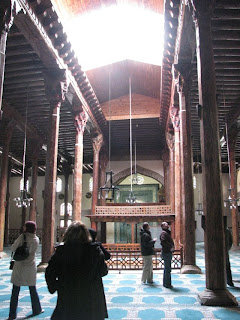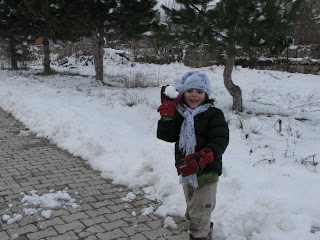Come, come, whoever you are.
Wonderer, worshipper, lover of leaving.
It doesn't matter.
Ours is not a caravan of despair.
Come, even if you have broken your vow
a thousand times
Come, yet again, come, come.
Despite the non-traditional nature of his religious teachings, his tomb is still regarded as an important place of pilgrimage for all Muslims, and the people of Konya, although very conservative in their own beliefs, are proud of their city's role as the home of the Mevlana.
The skyline of Konya , backed by gorgeous mountains, announces its religious devotion in all its interesting confusion. Look closely at the skyscraper in this picture:


DETAIL OF THE TOP OF THE SKYSCRAPER
Skyscrapers are considered by the citizens of Konya to be indicators that they are modern and advanced, so they love to construct them whenever possible. The top of this skyscraper in particular uses the forms of two important buildings: the lower pavilion-like section is based on the Dome of the Rock in Jerusalem, the holiest of Muslim sites, while the smaller section on top of that is the same shape as the tomb of Rumi, whose mysticism is both part of, and at odds with, mainstream Islam.
We took an overnight train from Istanbul to Konya, and when we arrived we found a frozen city, covered in snow. None of the mosques or museums we visited had heat, so by the end of each day we were fairly frozen!
The main point of the trip was to see some of the most important examples of Seljuk architecture. Scott, the Director of the Institute, is a Seljuk historian, so it was very educational to tour the sites with him. The Seljuks were a pre-Ottoman state that ruled much of Anatolia, into Persia, in the 11th-14th centuries. Konya was their capital, and much of their architecture remains.
Before seeing the buildings in town, though, we traveled outside the city to a caravansaray to see a fine example of the buildings that were used by caravans when they were traveling to and from Konya. This one is called Zazadin Han:

Our next stop was to see what is left of the original Seljuk walls of Konya. They are now to be found (and visited, if you have the right connections), in the basement of a "dershane", a center for test preparation. You can see all the college-prep test booklets stacked against them in the pictures.

Next we entered the Karatay Madrasa, (a madrasa, or medrese, as I have mentioned in previous posts, is a school for Quaranic learning). This building has been converted into a museum, and we were not supposed to take photos inside. I had, however, snapped one picture of the amazing tiled dome before they told us that. These tiles are especially amazing because the Seljuks did not have the technology to fire tiles with more than one color on them, so they had to fire each small piece of the design separately, in whatever shape they wanted, then fit them together to achieve the desired pattern:

From there we moved to another Madrasa, the Ince Minare ("Slender Minaret") Madrasa, which is now a museum of architectural elements such as stone and woodwork. Its highly-decorated carved portal is one of the most important remaining Seljuk monuments:

Our final stop of the day was the Alaeddin Camii, in the interior courtyard of which stand the tombs of most of the Seljuk rulers. None of my pictures of this are very good, probably because I was too cold to take anything decent by this point.
That night we were able to meet up at the hotel with a fellow Fulbrighter, Dee Dee from South Carolina, and her husband Michael. We were happy to hear that they love living in Konya, although it is a more difficult assignment because it is so much more traditional and conservative than Istanbul. Dee Dee was also able to join us for our tours the next day, which was nice.
We started our second day with a trip to the tomb complex of Rumi. It's greenish-blue tiled tower is the most recognized landmark of the city. No pictures are allowed inside, but in addition to the actual tombs of Rumi, his father, and various important individuals, we saw many other objects associated with the history of the Whirling Dervishes, such as musical instruments and manuscripts. It is really an amazing place to visit, and we highly recommend it.

After a nice lunch, we visited two more sites in town: the archaeological museum which, although not very well-kept or labeled, houses some very interesting objects, including this sarcophagus depicting the 12 Labors of Hercules:


Another interesting sarcophagus in the museum had an unusual version of the Jonah story. I've never seen him being swallowed headfirst before!

Next door to the museum is the Sahip Ata Kulliyesi, a dervish "convent." As with many of the other buildings we saw in Konya, the inside was beautifully tiled. Although the main central area has been rather harshly restored, the tomb area to the side is remarkable for the beauty of the tiling not only on the building, but on the coffins themselves:


The last goal of our tour was not in Konya itself, but in the nearby town of Beyshehir. Visiting required a drive of an hour and a half or so through beautiful snowy countryside:

The main attraction in Beyshehir is the Eshrefoglu mosque, one of a rare type of mosque with a wooden interior, beautifully painted. It was constructed in the Medieval period, late 13th century, and is in a remarkable state of preservation, considering that the columns, roof, and furniture are all made of wood:


A DETAIL OF THE CARVED AND PAINTED DECORATION AT THE TOP OF ONE OF THE COLUMNS
Beyshehir's other claim to fame is its location on the shores of Turkey's largest freshwater lake (for those of you who are wondering, Lake Van's water is part saline, part fresh), which shares the name Beyshehir. We were able to spend a half hour or so walking by the water and teaching Tsameret and Ilan's children to throw snowballs. Since they are from Israel, it was their first time to see snow!

BEAUTIFUL LAKE BEYSHEHIR

THE CITY SITS ON ITS SHORE, LOOKING VERY EUROPEAN

A HAPPY, BUT THOROUGHLY FROZEN, GROUP OF FELLOWS

Soon it was time to drive back to Konya to catch another overnight train back to Istanbul. We were prepared for a boring night: a little dinner, some chatting, then off to bed. But we found ourselves sharing the dining car with a group of young Turkish soldiers enjoying their last night of freedom before reporting for sniper training in Istanbul the next day. One of them had a guitar, and our "boring night" turned into hours of singing (and even some dancing) as we rode through the frozen Anatolian plain. It was definitely a night to remember!

1 comment:
You should post the video of the night of music on the train if you can get your hands on it.
Post a Comment